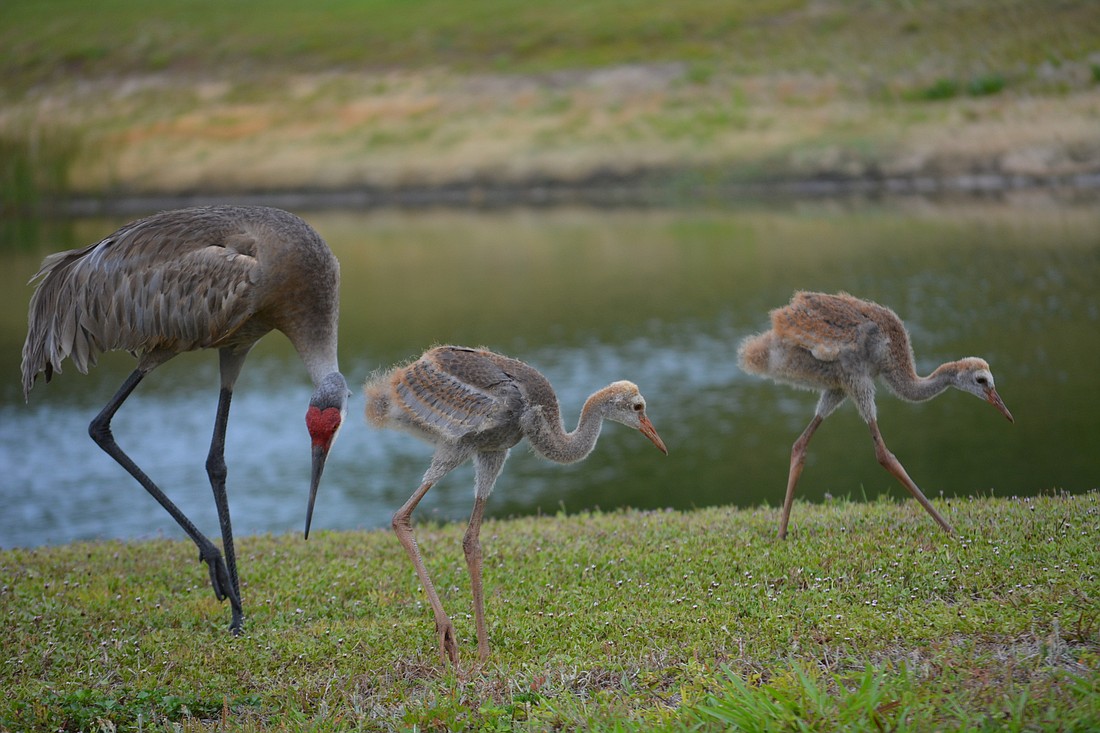- April 24, 2024
-
-
Loading

Loading

River Club’s John Sackett stood on the sidewalk of Hidden River Trail, facing east, and watched a family of sandhill cranes make its way across the roadway, just past a yellow deer crossing sign.
To him, it was a beautiful sight, albeit a sad one with only three birds — one adult and two babies — traversing the roadway. One of the parents was hit by a car March 30.
“That’s almost exactly where it died,” Sackett said of where the birds were crossing the road. “There’s a sign warning people about wildlife, and they still can’t seem to slow down.”
Sackett and his wife, Ellen Sackett — along with a slew of other bird watchers and nature photographers — have been watching the sandhill crane nest at the southern end of Otter Lake, near the intersection of Lakewood Ranch Boulevard, which has a speed limit of 35 mph, and Hidden River Trail, which has a speed limit of 25 mph.
The colts hatched March 2.
Sandhill crane babies will stay with their parents for about 10 months. It’s now, when colts are foraging with their parents, that the birds are the most vulnerable, said Tim Dellinger, an assistant research scientist with the Florida Fish and Wildlife Conservation Commission.
Sandhill crane eggs take about a month to hatch. Then, the baby birds, called colts, remain flightless and stay with their parents for up to 90 days. Parents remain on the ground with them during that time.
Even after the colts learn to fly, they remain with their families, generally for 10 months to a year, or whenever the parents shoo them away.
Dellinger said the cranes are considered water birds, because they roost in water at night and also build their nests — floating platforms — in the water. They prefer shallow marshlands or the edge of lakes, where they generally are found in developed communities. However, the birds travel upland for much of the day as they forage for food. They like wide open spaces because they are not particularly agile flyers.
They are unique in that they do not seem to feel endangered by cars.
“They see from point to point when they are walking,” he said. “A lot of these birds are foraging too close to the roads. People think they will get out of the way, but they won’t.”
Sackett hopes the death of the sandhill crane in Lakewood Ranch will serve as a reminder to that fact. The birds don’t just jump into traffic; they walk into it. And drivers, he said, can help protect them simply by paying better attention.
“We’re fortunate to be surrounded by nature, and yet people blast past it,” Sackett said “It’s awesome. Unfortunately, though, it creates a lot of conflict. If we’d just slow down a little bit, it would make a difference.”
Paul Chetlain, director of operations for the Lakewood Ranch Inter-District Authority, said his staff is aware of only three instances in the past seven years in which sandhill cranes were killed by vehicles on district roadways.
“We hate to see it,” Chetlain said. “But I notice people yielding to them all the time.”
He said the number is low considering how much time the birds spend near roadways.